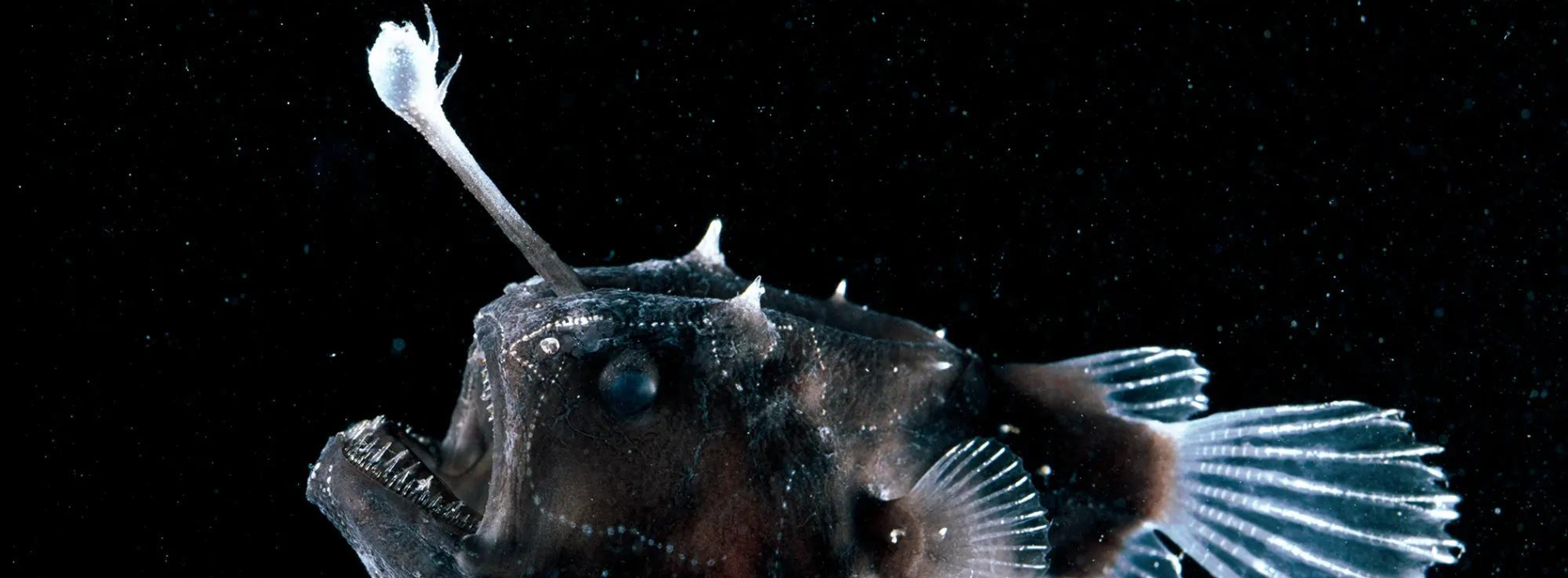- Introduction
-
The Anglerfish anatomy
- Habitat and Appearance
- Unique Adaptations
- Diversity and Classification
-
The Lure of the Anglerfish
- Feeding Habits
- The Fishing Pole of the Deep
-
The Extraordinary Reproduction of Anglerfish
- Sexual Dimorphism
- Symbiotic Mating
-
The Fascinating Behavior of Anglerfish
- Swimming and Energy Conservation
- Predatory Techniques
- Threats and Conservation
- Anglerfish in Human Culture
- Our last words...
The Anglerfish anatomy
Habitat and Appearance

Anglerfish are predominantly found in the murky depths of the Atlantic and Antarctic oceans, often residing up to a mile below the surface. However, some species can also be found in shallow, tropical environments. These fascinating creatures have adapted to survive in the most inhospitable habitat on Earth - the lightless bottom of the sea.
They are known for their distinctive appearance. Typically dark gray to dark brown in color, they possess enormous crescent-shaped mouths filled with sharp, translucent teeth. Their most striking feature, found only in females, is a dorsal spine that protrudes above their mouths like a fishing pole. This unique adaptation gives them their name. Tipped with a lure of luminous flesh, this built-in rod baits prey close enough to be snatched.
Unique Adaptations

Anglerfish have evolved a range of unique adaptations to thrive in their deep-sea environment. One of their most fascinating adaptations is their ability to produce light. This creature possesses a modified fin ray, known as the esca or illicium, which acts as a luminescent lure for other fish. This luminescence is achieved through a symbiotic relationship with bacteria that dwell in and around the esca. The bacteria produce light, attracting unsuspecting prey towards them.
Another remarkable adaptation of this fish is its ability to swallow prey up to twice its own size. Their mouths are so large and their bodies so pliable that they can consume prey larger than themselves. This unique feeding mechanism allows them to survive in the deep sea, where food is scarce and competition is fierce.
Diversity and Classification
This specimen belong to the teleost order Lophiiformes, which comprises more than 200 species. These species can be further classified into various families, each with its own unique characteristics. Some notable families include Lophiidae (goosefishes or monkfishes), Antennariidae (frogfishes), and Ceratiidae (warty seadevils).
Within this deep-sea species, there is a remarkable sexual dimorphism. Males of these species can be several orders of magnitude smaller than females. In some cases, males physically fuse with females, connecting to their skin and bloodstream. This fusion allows the male to become a permanent parasitic mate, relying on the female for survival and reproduction.
The Lure of the Anglerfish
Feeding Habits

These creatures are carnivorous creatures with specialized feeding habits. Their large mouths and sharp teeth allow them to capture and devour their prey with ease. They primarily feed on a variety of fish and crustaceans, which they attract using their luminescent lure. Their ability to produce light gives it a significant advantage in the dark depths of the ocean, where prey visibility is limited.
They are opportunistic foragers, meaning they show a range of preferred prey and increased selectivity for certain types of food. For example, threadfin anglerfish off the Pacific coast of Central America primarily feed on pandalid shrimp. Their low-energy consumption and the intermittent availability of food in their environment contribute to their ability to survive in resource-poor conditions.
The Fishing Pole of the Deep

Their most distinctive feature is its illicium, a modified fin ray that extends from its head like a fishing pole. This illicium acts as a lure, attracting unsuspecting prey towards them. The illicium can be wiggled by this creature, making it resemble a prey animal and enticing other fish to come closer. Once the prey is within reach, it swiftly captures it with its enormous mouth and sharp teeth.
The luminescence of the anglerfish's illicium is a result of its symbiotic relationship with bacteria. These bacteria produce light, which helps to attract prey and enhance their chances of successful feeding. Their ability to control and manipulate its illicium is a testament to its incredible adaptability and survival strategies in the deep sea.
The Extraordinary Reproduction of Anglerfish
Sexual Dimorphism

One of the most fascinating aspects of anglerfish biology is their extreme sexual dimorphism. In this species, males are significantly smaller than females. This size difference is so pronounced that males may be several orders of magnitude smaller than females.
The sexual dimorphism of them is thought to have evolved due to the low density of females in deep-sea environments. Encounters between males and females are rare, making it challenging for males to find mates. The extreme size difference ensures that when a female is ready to spawn, she has a mate readily available.
Symbiotic Mating

The reproductive strategy of anglerfish is truly extraordinary. In some species, males attach themselves to females and become permanent parasitic mates. When a young, free-swimming male encounters a female, he latches onto her using his sharp teeth. Over time, the male physically fuses with the female, connecting to her skin and bloodstream. This fusion results in the male losing his eyes and internal organs, except for the testes.
This symbiotic mating strategy allows the male to rely on the female for survival, obtaining nutrients through their shared circulatory system. In return, the male provides sperm to the female for reproduction. A single female can carry six or more males on her body, forming a unique and complex relationship in the depths of the ocean.
The Fascinating Behavior of Anglerfish
Swimming and Energy Conservation
They have adapted to conserve energy in their dark and resource-poor environment. When approached, they often retreat rapidly but can also drift passively, oriented at any angle. Their swimming behavior is intermittent, with a speed of 0.24 body lengths per second. This lethargic behavior is well-suited to the energy-poor conditions of the deep sea, allowing it to survive with limited food resources.
Another intriguing behavior observed in some species is inverted swimming. The fish float motionless, with their illicium hanging down stiffly in front of them. This behavior is believed to be an effort to entice prey and engage in low-energy opportunistic foraging and predation. When threatened, the anglerfish can exhibit burst swimming, even while inverted, showcasing their adaptability and survival instincts.
Predatory Techniques

Their predatory techniques are as unique as their appearance. Their large heads and sharp teeth are perfectly adapted for capturing and devouring prey. The inwardly inclined teeth line their enormous mouths, preventing prey from escaping once captured. The anglerfish can depress its teeth to allow prey to glide towards its stomach, facilitating efficient feeding.
The luminescent lure of this fish plays a crucial role in their predatory success. By manipulating their illicium and resembling a prey animal, they attract other fish close enough to be captured. Some species even emit light from their illicium to further entice prey. This combination of adaptations and strategies makes the it an incredibly effective predator in the depths of the ocean.
Threats and Conservation
While anglerfish are not directly targeted by commercial fisheries, some species are impacted by fishing practices that target other deep-sea species. For example, Northwest European Lophius species are listed as being outside safe biological limits by the International Council for the Exploration of the Sea (ICES).
Additionally, they are known to occasionally rise to the surface during El Niño events, resulting in large groups of dead one floating on the surface. These events can have a significant impact on their populations, further highlighting the vulnerability of these mesmerizing creatures.
Conservation efforts for them primarily focus on sustainable fishing practices and the protection of their deep-sea habitats. It is essential to understand the ecological role of anglerfish in their respective ecosystems and work towards maintaining the delicate balance of marine life.
Anglerfish in Human Culture
The mysterious and captivating nature of this creature has inspired artists, writers, and filmmakers throughout history. Their unique appearance and extraordinary reproductive strategies have become symbols of fascination and intrigue. It have been featured in various works of fiction, including movies, books, and even video games, further perpetuating their mystique.
In scientific research, they have played a vital role in understanding the complexities of deep-sea ecosystems and the evolution of reproductive strategies. Their adaptations and behaviors have captivated researchers and continue to provide valuable insights into the wonders of the ocean.
If you want to learn more about special animals, go here !
Our last words...
The world of the anglerfish is a realm of darkness and enchantment, where beauty meets mystery. These mesmerizing creatures have evolved unique adaptations to survive in the depths of the ocean, from their luminescent lures to their extraordinary reproductive strategies. As we delve deeper into the mysteries of the deep sea, this fish continues to captivate our imagination and push the boundaries of our understanding. Let us marvel at the wonders of this remarkable creature and strive to protect the fragile ecosystems that they call home.
We hope you've liked this article about the anglerfish !
Feel free to subscribe to our private newsletter to receive more exclusive article. You will also receive a 10% bonus discount for our sea world catalogue. You will be notified via email whenever we release a new wonderful jewelry piece of the ocean.
Feel free also to go check out our website, we provide the best sea content and we offer you the best nautical jewelry all around the globe !





















